Professional Health Competencies: Schizophrenia Case Study 400871
VerifiedAdded on 2023/06/11
|8
|2216
|254
Case Study
AI Summary
This case study focuses on the management of a 22-year-old college student, Jane, diagnosed with paranoid schizophrenia, detailing her physical and emotional impairments affecting her daily life and academic performance. It describes an intervention strategy where a nurse establishes a connection with Jane to facilitate open communication, emphasizing the importance of empathy and genuine care. The study utilizes the International Classification of Functioning, Disability and Health (ICF) framework to understand Jane's condition comprehensively and involves a psychiatrist who diagnoses Jane using ICD-10 criteria and develops a structured treatment plan. Key professionalism characteristics, such as beneficence, non-maleficence, honesty, and respect, are highlighted to ensure ethical and patient-centered care. Person-centered strategies, including individual support and planned activities, are implemented to encourage Jane's active participation in her treatment and improve her overall well-being. The case study emphasizes the importance of interprofessional collaboration and holistic approaches in managing schizophrenia.
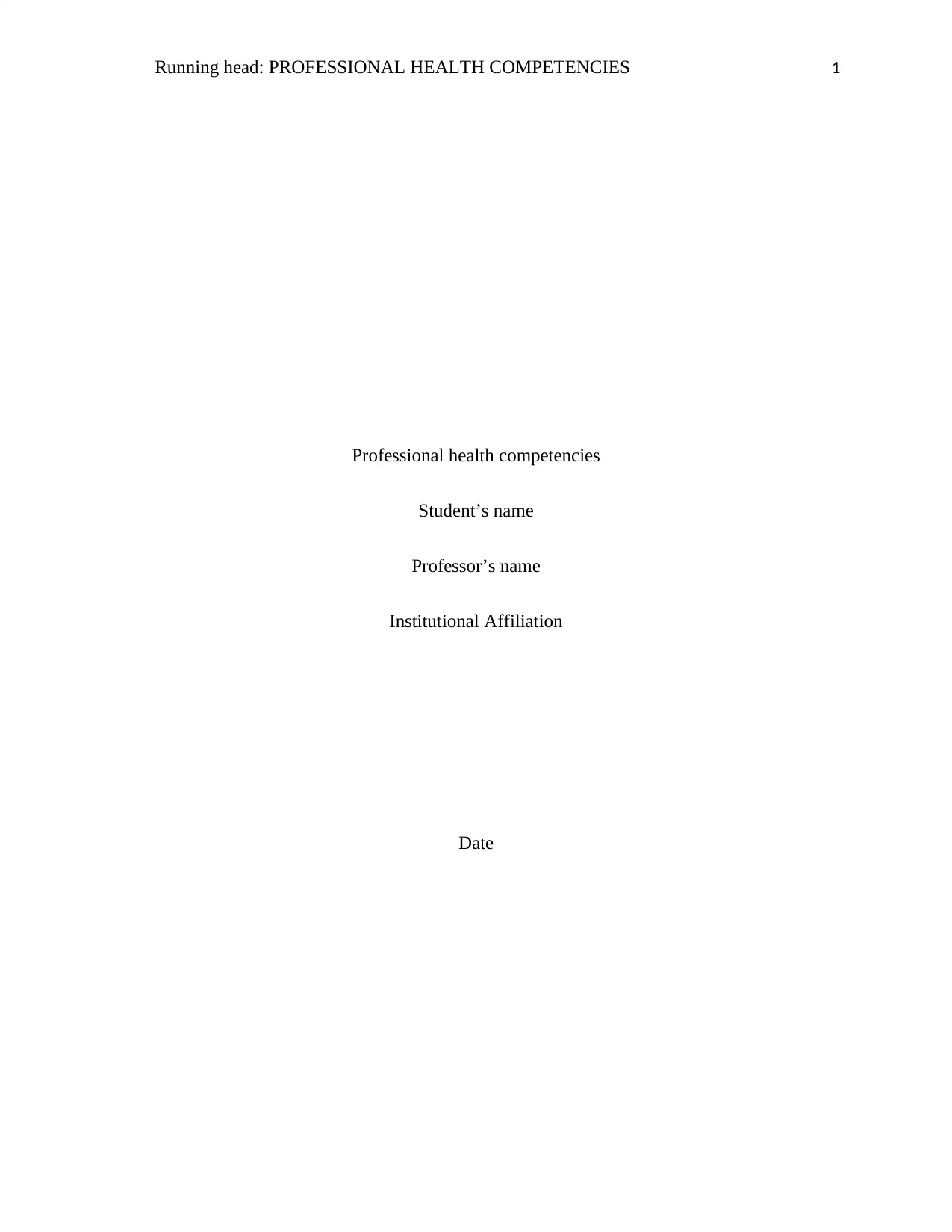
Running head: PROFESSIONAL HEALTH COMPETENCIES 1
Professional health competencies
Student’s name
Professor’s name
Institutional Affiliation
Date
Professional health competencies
Student’s name
Professor’s name
Institutional Affiliation
Date
Paraphrase This Document
Need a fresh take? Get an instant paraphrase of this document with our AI Paraphraser
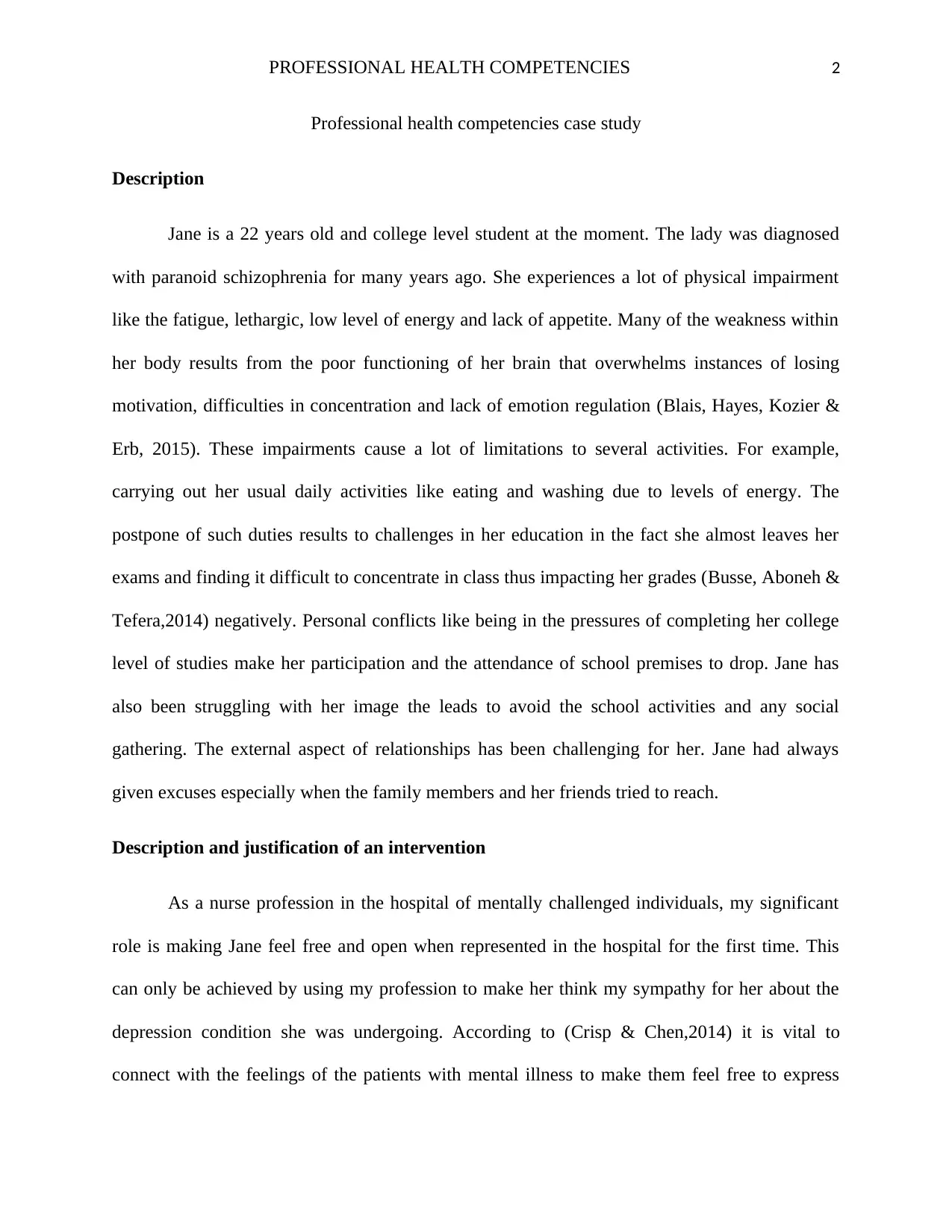
PROFESSIONAL HEALTH COMPETENCIES 2
Professional health competencies case study
Description
Jane is a 22 years old and college level student at the moment. The lady was diagnosed
with paranoid schizophrenia for many years ago. She experiences a lot of physical impairment
like the fatigue, lethargic, low level of energy and lack of appetite. Many of the weakness within
her body results from the poor functioning of her brain that overwhelms instances of losing
motivation, difficulties in concentration and lack of emotion regulation (Blais, Hayes, Kozier &
Erb, 2015). These impairments cause a lot of limitations to several activities. For example,
carrying out her usual daily activities like eating and washing due to levels of energy. The
postpone of such duties results to challenges in her education in the fact she almost leaves her
exams and finding it difficult to concentrate in class thus impacting her grades (Busse, Aboneh &
Tefera,2014) negatively. Personal conflicts like being in the pressures of completing her college
level of studies make her participation and the attendance of school premises to drop. Jane has
also been struggling with her image the leads to avoid the school activities and any social
gathering. The external aspect of relationships has been challenging for her. Jane had always
given excuses especially when the family members and her friends tried to reach.
Description and justification of an intervention
As a nurse profession in the hospital of mentally challenged individuals, my significant
role is making Jane feel free and open when represented in the hospital for the first time. This
can only be achieved by using my profession to make her think my sympathy for her about the
depression condition she was undergoing. According to (Crisp & Chen,2014) it is vital to
connect with the feelings of the patients with mental illness to make them feel free to express
Professional health competencies case study
Description
Jane is a 22 years old and college level student at the moment. The lady was diagnosed
with paranoid schizophrenia for many years ago. She experiences a lot of physical impairment
like the fatigue, lethargic, low level of energy and lack of appetite. Many of the weakness within
her body results from the poor functioning of her brain that overwhelms instances of losing
motivation, difficulties in concentration and lack of emotion regulation (Blais, Hayes, Kozier &
Erb, 2015). These impairments cause a lot of limitations to several activities. For example,
carrying out her usual daily activities like eating and washing due to levels of energy. The
postpone of such duties results to challenges in her education in the fact she almost leaves her
exams and finding it difficult to concentrate in class thus impacting her grades (Busse, Aboneh &
Tefera,2014) negatively. Personal conflicts like being in the pressures of completing her college
level of studies make her participation and the attendance of school premises to drop. Jane has
also been struggling with her image the leads to avoid the school activities and any social
gathering. The external aspect of relationships has been challenging for her. Jane had always
given excuses especially when the family members and her friends tried to reach.
Description and justification of an intervention
As a nurse profession in the hospital of mentally challenged individuals, my significant
role is making Jane feel free and open when represented in the hospital for the first time. This
can only be achieved by using my profession to make her think my sympathy for her about the
depression condition she was undergoing. According to (Crisp & Chen,2014) it is vital to
connect with the feelings of the patients with mental illness to make them feel free to express
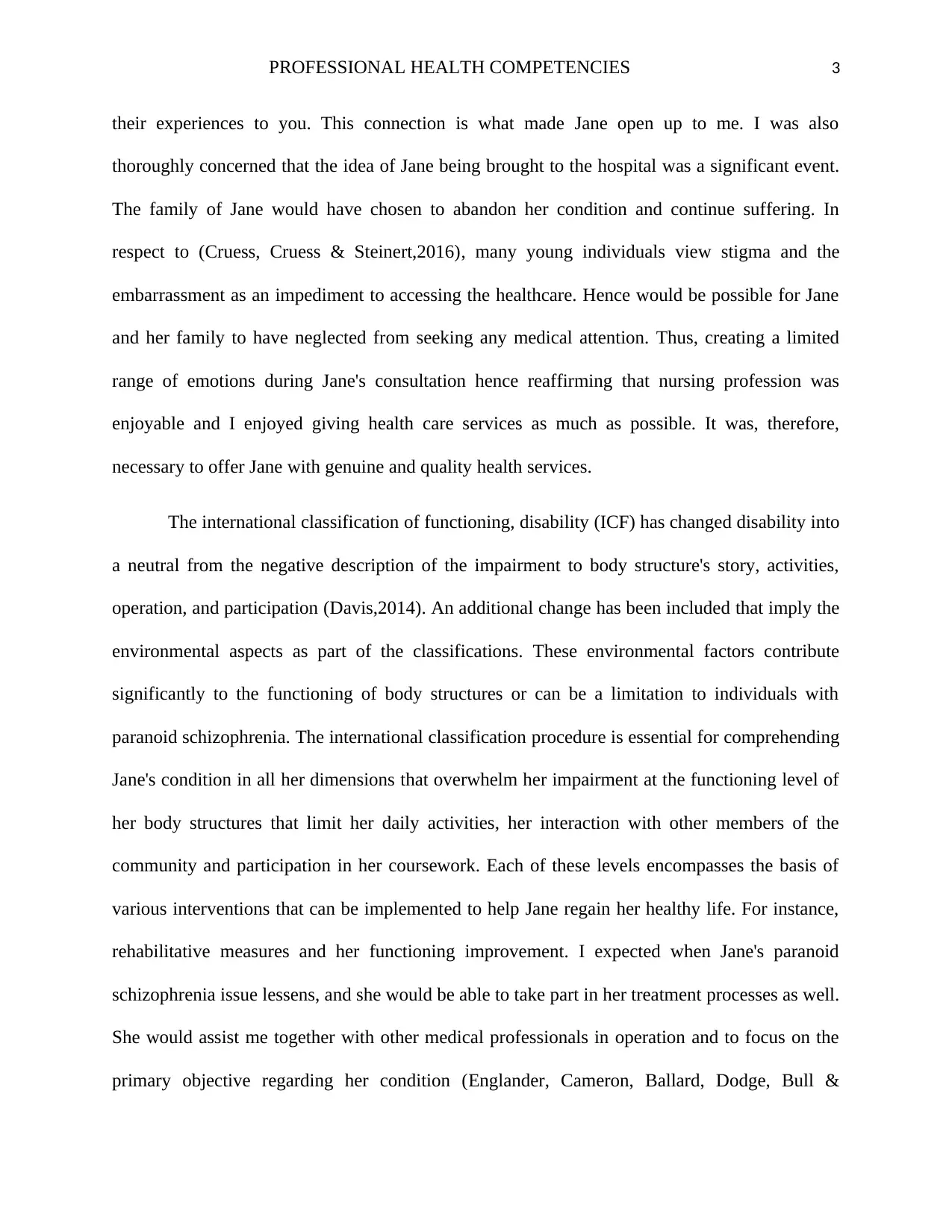
PROFESSIONAL HEALTH COMPETENCIES 3
their experiences to you. This connection is what made Jane open up to me. I was also
thoroughly concerned that the idea of Jane being brought to the hospital was a significant event.
The family of Jane would have chosen to abandon her condition and continue suffering. In
respect to (Cruess, Cruess & Steinert,2016), many young individuals view stigma and the
embarrassment as an impediment to accessing the healthcare. Hence would be possible for Jane
and her family to have neglected from seeking any medical attention. Thus, creating a limited
range of emotions during Jane's consultation hence reaffirming that nursing profession was
enjoyable and I enjoyed giving health care services as much as possible. It was, therefore,
necessary to offer Jane with genuine and quality health services.
The international classification of functioning, disability (ICF) has changed disability into
a neutral from the negative description of the impairment to body structure's story, activities,
operation, and participation (Davis,2014). An additional change has been included that imply the
environmental aspects as part of the classifications. These environmental factors contribute
significantly to the functioning of body structures or can be a limitation to individuals with
paranoid schizophrenia. The international classification procedure is essential for comprehending
Jane's condition in all her dimensions that overwhelm her impairment at the functioning level of
her body structures that limit her daily activities, her interaction with other members of the
community and participation in her coursework. Each of these levels encompasses the basis of
various interventions that can be implemented to help Jane regain her healthy life. For instance,
rehabilitative measures and her functioning improvement. I expected when Jane's paranoid
schizophrenia issue lessens, and she would be able to take part in her treatment processes as well.
She would assist me together with other medical professionals in operation and to focus on the
primary objective regarding her condition (Englander, Cameron, Ballard, Dodge, Bull &
their experiences to you. This connection is what made Jane open up to me. I was also
thoroughly concerned that the idea of Jane being brought to the hospital was a significant event.
The family of Jane would have chosen to abandon her condition and continue suffering. In
respect to (Cruess, Cruess & Steinert,2016), many young individuals view stigma and the
embarrassment as an impediment to accessing the healthcare. Hence would be possible for Jane
and her family to have neglected from seeking any medical attention. Thus, creating a limited
range of emotions during Jane's consultation hence reaffirming that nursing profession was
enjoyable and I enjoyed giving health care services as much as possible. It was, therefore,
necessary to offer Jane with genuine and quality health services.
The international classification of functioning, disability (ICF) has changed disability into
a neutral from the negative description of the impairment to body structure's story, activities,
operation, and participation (Davis,2014). An additional change has been included that imply the
environmental aspects as part of the classifications. These environmental factors contribute
significantly to the functioning of body structures or can be a limitation to individuals with
paranoid schizophrenia. The international classification procedure is essential for comprehending
Jane's condition in all her dimensions that overwhelm her impairment at the functioning level of
her body structures that limit her daily activities, her interaction with other members of the
community and participation in her coursework. Each of these levels encompasses the basis of
various interventions that can be implemented to help Jane regain her healthy life. For instance,
rehabilitative measures and her functioning improvement. I expected when Jane's paranoid
schizophrenia issue lessens, and she would be able to take part in her treatment processes as well.
She would assist me together with other medical professionals in operation and to focus on the
primary objective regarding her condition (Englander, Cameron, Ballard, Dodge, Bull &
⊘ This is a preview!⊘
Do you want full access?
Subscribe today to unlock all pages.

Trusted by 1+ million students worldwide
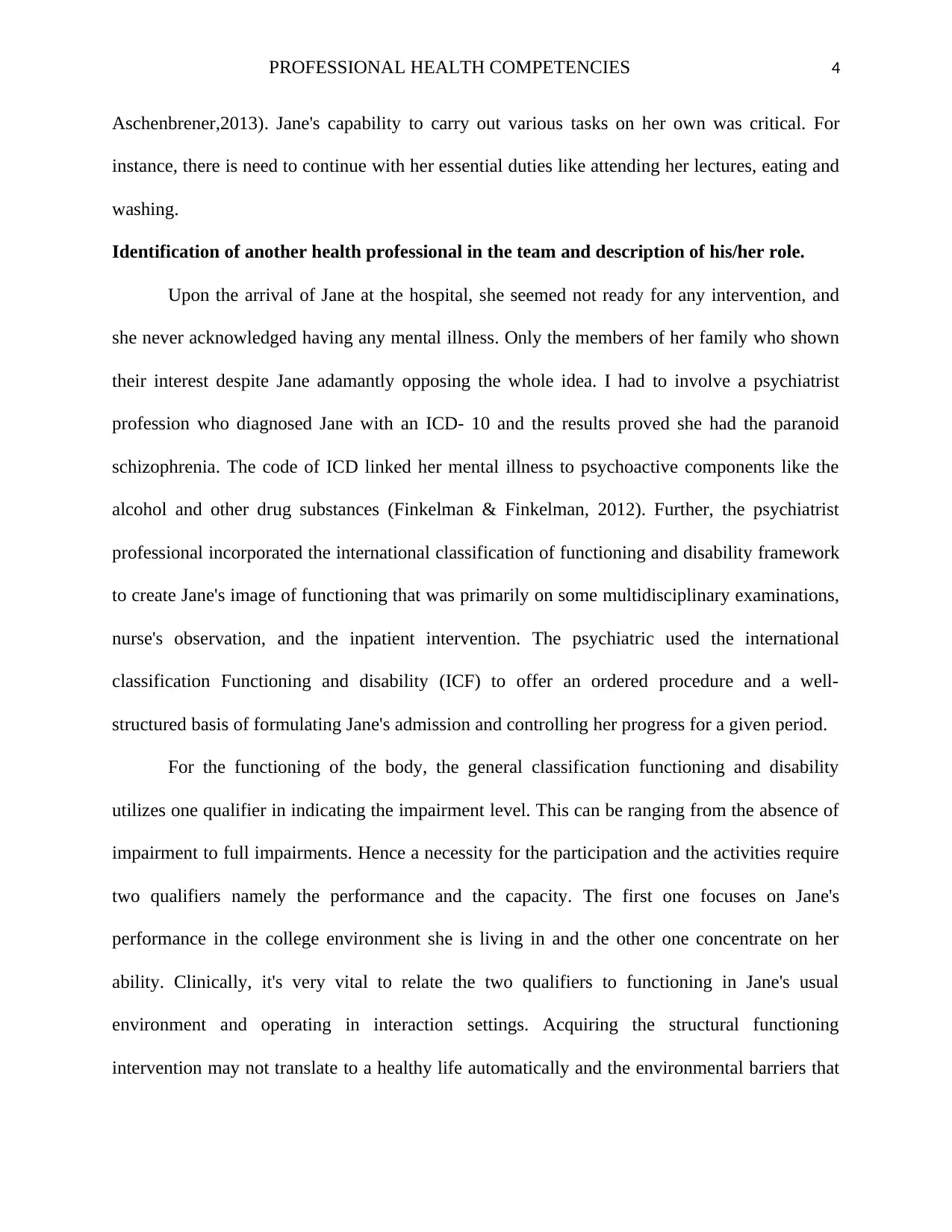
PROFESSIONAL HEALTH COMPETENCIES 4
Aschenbrener,2013). Jane's capability to carry out various tasks on her own was critical. For
instance, there is need to continue with her essential duties like attending her lectures, eating and
washing.
Identification of another health professional in the team and description of his/her role.
Upon the arrival of Jane at the hospital, she seemed not ready for any intervention, and
she never acknowledged having any mental illness. Only the members of her family who shown
their interest despite Jane adamantly opposing the whole idea. I had to involve a psychiatrist
profession who diagnosed Jane with an ICD- 10 and the results proved she had the paranoid
schizophrenia. The code of ICD linked her mental illness to psychoactive components like the
alcohol and other drug substances (Finkelman & Finkelman, 2012). Further, the psychiatrist
professional incorporated the international classification of functioning and disability framework
to create Jane's image of functioning that was primarily on some multidisciplinary examinations,
nurse's observation, and the inpatient intervention. The psychiatric used the international
classification Functioning and disability (ICF) to offer an ordered procedure and a well-
structured basis of formulating Jane's admission and controlling her progress for a given period.
For the functioning of the body, the general classification functioning and disability
utilizes one qualifier in indicating the impairment level. This can be ranging from the absence of
impairment to full impairments. Hence a necessity for the participation and the activities require
two qualifiers namely the performance and the capacity. The first one focuses on Jane's
performance in the college environment she is living in and the other one concentrate on her
ability. Clinically, it's very vital to relate the two qualifiers to functioning in Jane's usual
environment and operating in interaction settings. Acquiring the structural functioning
intervention may not translate to a healthy life automatically and the environmental barriers that
Aschenbrener,2013). Jane's capability to carry out various tasks on her own was critical. For
instance, there is need to continue with her essential duties like attending her lectures, eating and
washing.
Identification of another health professional in the team and description of his/her role.
Upon the arrival of Jane at the hospital, she seemed not ready for any intervention, and
she never acknowledged having any mental illness. Only the members of her family who shown
their interest despite Jane adamantly opposing the whole idea. I had to involve a psychiatrist
profession who diagnosed Jane with an ICD- 10 and the results proved she had the paranoid
schizophrenia. The code of ICD linked her mental illness to psychoactive components like the
alcohol and other drug substances (Finkelman & Finkelman, 2012). Further, the psychiatrist
professional incorporated the international classification of functioning and disability framework
to create Jane's image of functioning that was primarily on some multidisciplinary examinations,
nurse's observation, and the inpatient intervention. The psychiatric used the international
classification Functioning and disability (ICF) to offer an ordered procedure and a well-
structured basis of formulating Jane's admission and controlling her progress for a given period.
For the functioning of the body, the general classification functioning and disability
utilizes one qualifier in indicating the impairment level. This can be ranging from the absence of
impairment to full impairments. Hence a necessity for the participation and the activities require
two qualifiers namely the performance and the capacity. The first one focuses on Jane's
performance in the college environment she is living in and the other one concentrate on her
ability. Clinically, it's very vital to relate the two qualifiers to functioning in Jane's usual
environment and operating in interaction settings. Acquiring the structural functioning
intervention may not translate to a healthy life automatically and the environmental barriers that
Paraphrase This Document
Need a fresh take? Get an instant paraphrase of this document with our AI Paraphraser
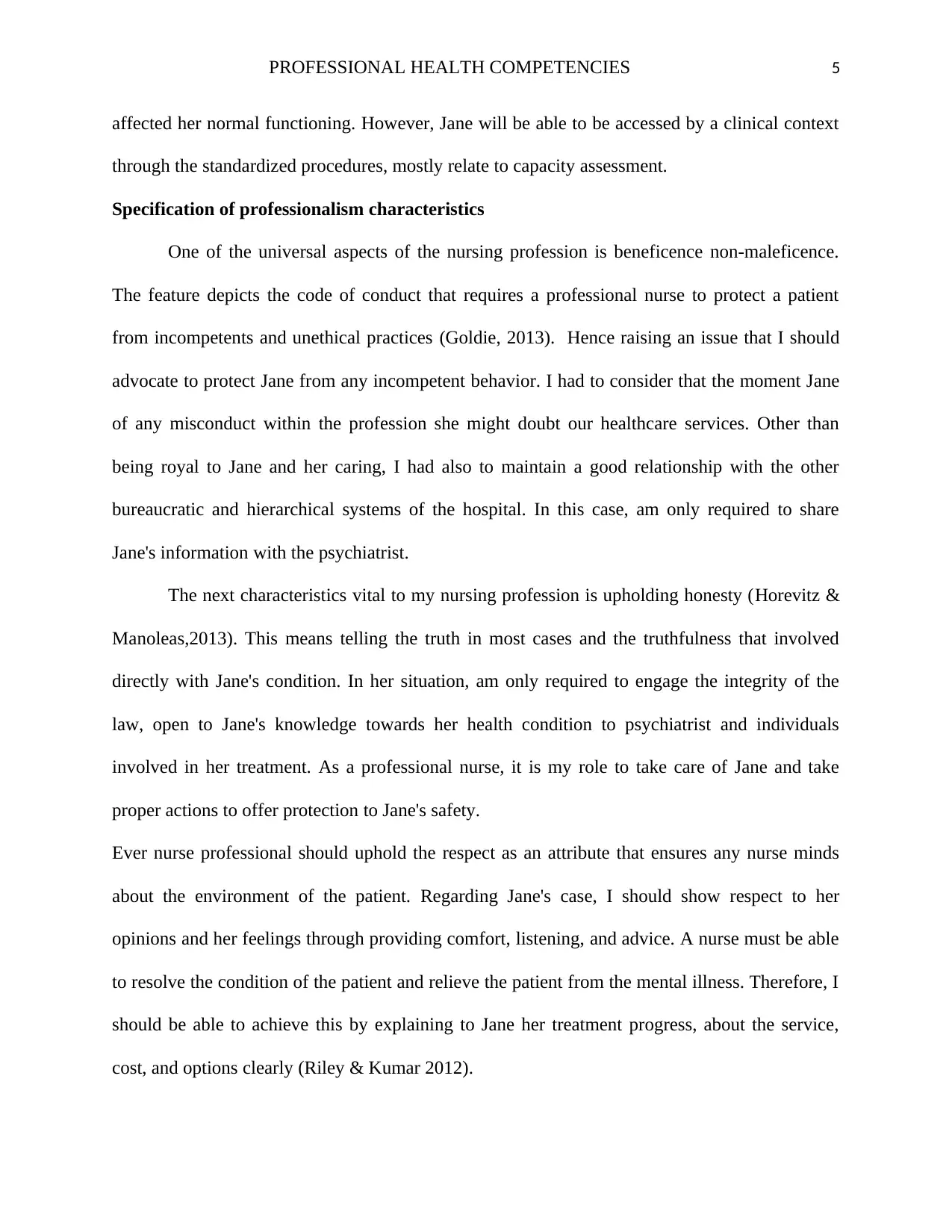
PROFESSIONAL HEALTH COMPETENCIES 5
affected her normal functioning. However, Jane will be able to be accessed by a clinical context
through the standardized procedures, mostly relate to capacity assessment.
Specification of professionalism characteristics
One of the universal aspects of the nursing profession is beneficence non-maleficence.
The feature depicts the code of conduct that requires a professional nurse to protect a patient
from incompetents and unethical practices (Goldie, 2013). Hence raising an issue that I should
advocate to protect Jane from any incompetent behavior. I had to consider that the moment Jane
of any misconduct within the profession she might doubt our healthcare services. Other than
being royal to Jane and her caring, I had also to maintain a good relationship with the other
bureaucratic and hierarchical systems of the hospital. In this case, am only required to share
Jane's information with the psychiatrist.
The next characteristics vital to my nursing profession is upholding honesty (Horevitz &
Manoleas,2013). This means telling the truth in most cases and the truthfulness that involved
directly with Jane's condition. In her situation, am only required to engage the integrity of the
law, open to Jane's knowledge towards her health condition to psychiatrist and individuals
involved in her treatment. As a professional nurse, it is my role to take care of Jane and take
proper actions to offer protection to Jane's safety.
Ever nurse professional should uphold the respect as an attribute that ensures any nurse minds
about the environment of the patient. Regarding Jane's case, I should show respect to her
opinions and her feelings through providing comfort, listening, and advice. A nurse must be able
to resolve the condition of the patient and relieve the patient from the mental illness. Therefore, I
should be able to achieve this by explaining to Jane her treatment progress, about the service,
cost, and options clearly (Riley & Kumar 2012).
affected her normal functioning. However, Jane will be able to be accessed by a clinical context
through the standardized procedures, mostly relate to capacity assessment.
Specification of professionalism characteristics
One of the universal aspects of the nursing profession is beneficence non-maleficence.
The feature depicts the code of conduct that requires a professional nurse to protect a patient
from incompetents and unethical practices (Goldie, 2013). Hence raising an issue that I should
advocate to protect Jane from any incompetent behavior. I had to consider that the moment Jane
of any misconduct within the profession she might doubt our healthcare services. Other than
being royal to Jane and her caring, I had also to maintain a good relationship with the other
bureaucratic and hierarchical systems of the hospital. In this case, am only required to share
Jane's information with the psychiatrist.
The next characteristics vital to my nursing profession is upholding honesty (Horevitz &
Manoleas,2013). This means telling the truth in most cases and the truthfulness that involved
directly with Jane's condition. In her situation, am only required to engage the integrity of the
law, open to Jane's knowledge towards her health condition to psychiatrist and individuals
involved in her treatment. As a professional nurse, it is my role to take care of Jane and take
proper actions to offer protection to Jane's safety.
Ever nurse professional should uphold the respect as an attribute that ensures any nurse minds
about the environment of the patient. Regarding Jane's case, I should show respect to her
opinions and her feelings through providing comfort, listening, and advice. A nurse must be able
to resolve the condition of the patient and relieve the patient from the mental illness. Therefore, I
should be able to achieve this by explaining to Jane her treatment progress, about the service,
cost, and options clearly (Riley & Kumar 2012).
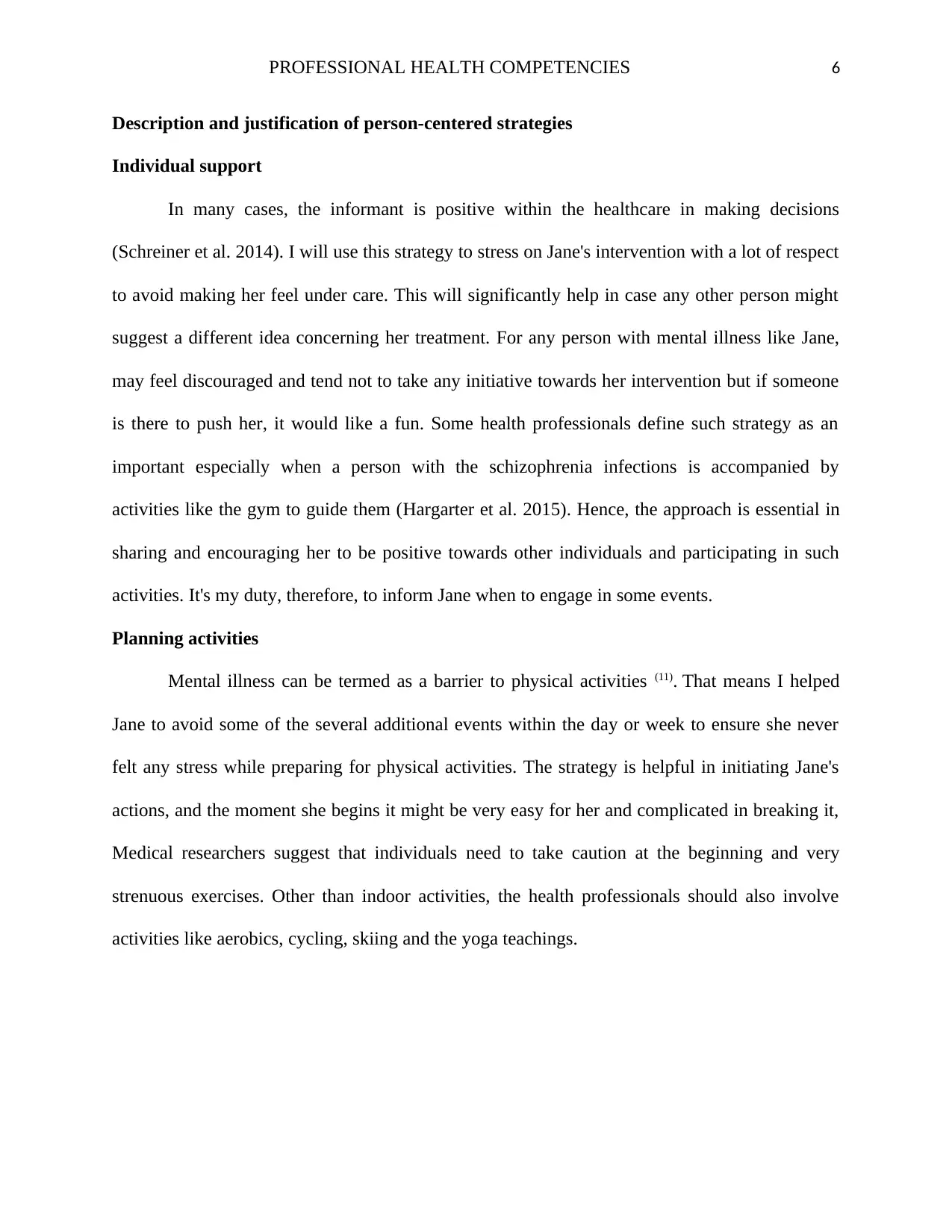
PROFESSIONAL HEALTH COMPETENCIES 6
Description and justification of person-centered strategies
Individual support
In many cases, the informant is positive within the healthcare in making decisions
(Schreiner et al. 2014). I will use this strategy to stress on Jane's intervention with a lot of respect
to avoid making her feel under care. This will significantly help in case any other person might
suggest a different idea concerning her treatment. For any person with mental illness like Jane,
may feel discouraged and tend not to take any initiative towards her intervention but if someone
is there to push her, it would like a fun. Some health professionals define such strategy as an
important especially when a person with the schizophrenia infections is accompanied by
activities like the gym to guide them (Hargarter et al. 2015). Hence, the approach is essential in
sharing and encouraging her to be positive towards other individuals and participating in such
activities. It's my duty, therefore, to inform Jane when to engage in some events.
Planning activities
Mental illness can be termed as a barrier to physical activities (11). That means I helped
Jane to avoid some of the several additional events within the day or week to ensure she never
felt any stress while preparing for physical activities. The strategy is helpful in initiating Jane's
actions, and the moment she begins it might be very easy for her and complicated in breaking it,
Medical researchers suggest that individuals need to take caution at the beginning and very
strenuous exercises. Other than indoor activities, the health professionals should also involve
activities like aerobics, cycling, skiing and the yoga teachings.
Description and justification of person-centered strategies
Individual support
In many cases, the informant is positive within the healthcare in making decisions
(Schreiner et al. 2014). I will use this strategy to stress on Jane's intervention with a lot of respect
to avoid making her feel under care. This will significantly help in case any other person might
suggest a different idea concerning her treatment. For any person with mental illness like Jane,
may feel discouraged and tend not to take any initiative towards her intervention but if someone
is there to push her, it would like a fun. Some health professionals define such strategy as an
important especially when a person with the schizophrenia infections is accompanied by
activities like the gym to guide them (Hargarter et al. 2015). Hence, the approach is essential in
sharing and encouraging her to be positive towards other individuals and participating in such
activities. It's my duty, therefore, to inform Jane when to engage in some events.
Planning activities
Mental illness can be termed as a barrier to physical activities (11). That means I helped
Jane to avoid some of the several additional events within the day or week to ensure she never
felt any stress while preparing for physical activities. The strategy is helpful in initiating Jane's
actions, and the moment she begins it might be very easy for her and complicated in breaking it,
Medical researchers suggest that individuals need to take caution at the beginning and very
strenuous exercises. Other than indoor activities, the health professionals should also involve
activities like aerobics, cycling, skiing and the yoga teachings.
⊘ This is a preview!⊘
Do you want full access?
Subscribe today to unlock all pages.

Trusted by 1+ million students worldwide
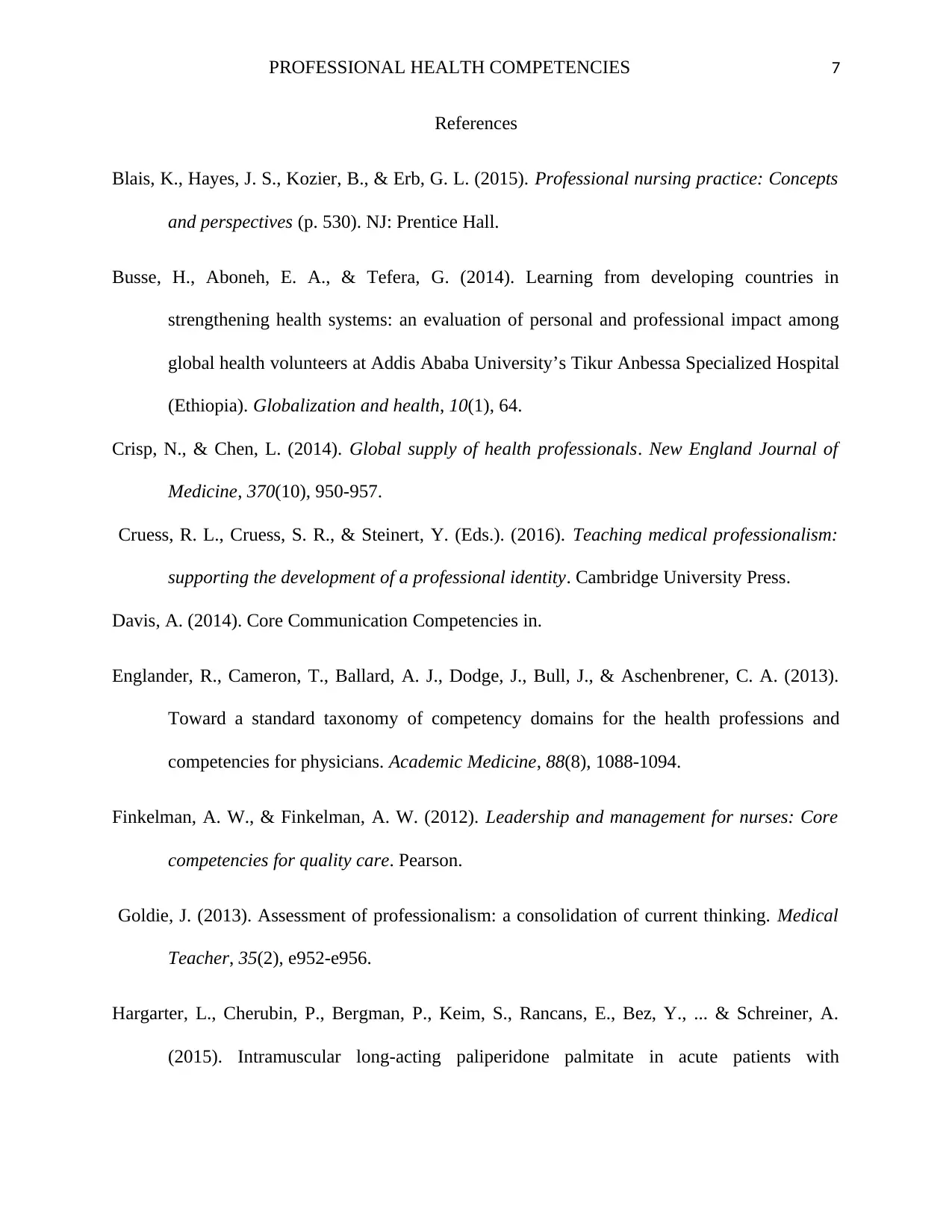
PROFESSIONAL HEALTH COMPETENCIES 7
References
Blais, K., Hayes, J. S., Kozier, B., & Erb, G. L. (2015). Professional nursing practice: Concepts
and perspectives (p. 530). NJ: Prentice Hall.
Busse, H., Aboneh, E. A., & Tefera, G. (2014). Learning from developing countries in
strengthening health systems: an evaluation of personal and professional impact among
global health volunteers at Addis Ababa University’s Tikur Anbessa Specialized Hospital
(Ethiopia). Globalization and health, 10(1), 64.
Crisp, N., & Chen, L. (2014). Global supply of health professionals. New England Journal of
Medicine, 370(10), 950-957.
Cruess, R. L., Cruess, S. R., & Steinert, Y. (Eds.). (2016). Teaching medical professionalism:
supporting the development of a professional identity. Cambridge University Press.
Davis, A. (2014). Core Communication Competencies in.
Englander, R., Cameron, T., Ballard, A. J., Dodge, J., Bull, J., & Aschenbrener, C. A. (2013).
Toward a standard taxonomy of competency domains for the health professions and
competencies for physicians. Academic Medicine, 88(8), 1088-1094.
Finkelman, A. W., & Finkelman, A. W. (2012). Leadership and management for nurses: Core
competencies for quality care. Pearson.
Goldie, J. (2013). Assessment of professionalism: a consolidation of current thinking. Medical
Teacher, 35(2), e952-e956.
Hargarter, L., Cherubin, P., Bergman, P., Keim, S., Rancans, E., Bez, Y., ... & Schreiner, A.
(2015). Intramuscular long-acting paliperidone palmitate in acute patients with
References
Blais, K., Hayes, J. S., Kozier, B., & Erb, G. L. (2015). Professional nursing practice: Concepts
and perspectives (p. 530). NJ: Prentice Hall.
Busse, H., Aboneh, E. A., & Tefera, G. (2014). Learning from developing countries in
strengthening health systems: an evaluation of personal and professional impact among
global health volunteers at Addis Ababa University’s Tikur Anbessa Specialized Hospital
(Ethiopia). Globalization and health, 10(1), 64.
Crisp, N., & Chen, L. (2014). Global supply of health professionals. New England Journal of
Medicine, 370(10), 950-957.
Cruess, R. L., Cruess, S. R., & Steinert, Y. (Eds.). (2016). Teaching medical professionalism:
supporting the development of a professional identity. Cambridge University Press.
Davis, A. (2014). Core Communication Competencies in.
Englander, R., Cameron, T., Ballard, A. J., Dodge, J., Bull, J., & Aschenbrener, C. A. (2013).
Toward a standard taxonomy of competency domains for the health professions and
competencies for physicians. Academic Medicine, 88(8), 1088-1094.
Finkelman, A. W., & Finkelman, A. W. (2012). Leadership and management for nurses: Core
competencies for quality care. Pearson.
Goldie, J. (2013). Assessment of professionalism: a consolidation of current thinking. Medical
Teacher, 35(2), e952-e956.
Hargarter, L., Cherubin, P., Bergman, P., Keim, S., Rancans, E., Bez, Y., ... & Schreiner, A.
(2015). Intramuscular long-acting paliperidone palmitate in acute patients with
Paraphrase This Document
Need a fresh take? Get an instant paraphrase of this document with our AI Paraphraser
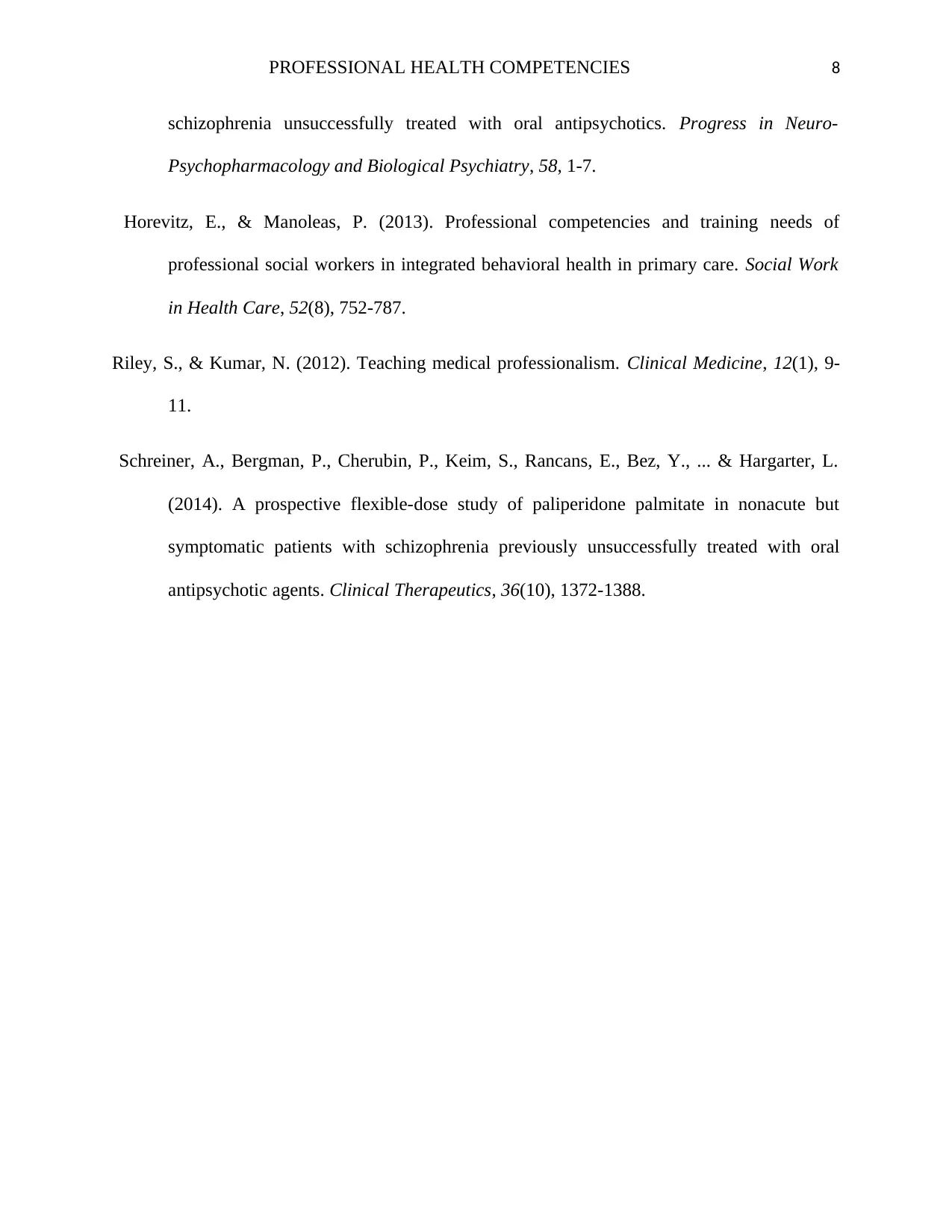
PROFESSIONAL HEALTH COMPETENCIES 8
schizophrenia unsuccessfully treated with oral antipsychotics. Progress in Neuro-
Psychopharmacology and Biological Psychiatry, 58, 1-7.
Horevitz, E., & Manoleas, P. (2013). Professional competencies and training needs of
professional social workers in integrated behavioral health in primary care. Social Work
in Health Care, 52(8), 752-787.
Riley, S., & Kumar, N. (2012). Teaching medical professionalism. Clinical Medicine, 12(1), 9-
11.
Schreiner, A., Bergman, P., Cherubin, P., Keim, S., Rancans, E., Bez, Y., ... & Hargarter, L.
(2014). A prospective flexible-dose study of paliperidone palmitate in nonacute but
symptomatic patients with schizophrenia previously unsuccessfully treated with oral
antipsychotic agents. Clinical Therapeutics, 36(10), 1372-1388.
schizophrenia unsuccessfully treated with oral antipsychotics. Progress in Neuro-
Psychopharmacology and Biological Psychiatry, 58, 1-7.
Horevitz, E., & Manoleas, P. (2013). Professional competencies and training needs of
professional social workers in integrated behavioral health in primary care. Social Work
in Health Care, 52(8), 752-787.
Riley, S., & Kumar, N. (2012). Teaching medical professionalism. Clinical Medicine, 12(1), 9-
11.
Schreiner, A., Bergman, P., Cherubin, P., Keim, S., Rancans, E., Bez, Y., ... & Hargarter, L.
(2014). A prospective flexible-dose study of paliperidone palmitate in nonacute but
symptomatic patients with schizophrenia previously unsuccessfully treated with oral
antipsychotic agents. Clinical Therapeutics, 36(10), 1372-1388.
1 out of 8
Related Documents
Your All-in-One AI-Powered Toolkit for Academic Success.
+13062052269
info@desklib.com
Available 24*7 on WhatsApp / Email
![[object Object]](/_next/static/media/star-bottom.7253800d.svg)
Unlock your academic potential
Copyright © 2020–2025 A2Z Services. All Rights Reserved. Developed and managed by ZUCOL.




